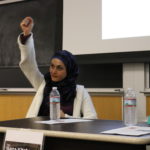The Gaza Kitchen: A Palestinian Culinary Journey, with Laila El-Haddad and Maggie Schmitt

I’ve never seen the authors of a cookbook less interested in talking about recipes, and thank goodness. When I sat down for Laila and Maggie’s lecture, I expected to hear about local cuisine and staple foods of the region, maybe about their own experiences preparing food. But after five minutes, Maggie told us that she initially became interested in Gaza through her humanitarian work. And Laila admitted to having little connection with the kitchen. She explained that her mother, grandmother, and aunts rather shirked traditional female roles because they viewed them as antiquated chores. She explained how confused her family was when she said she decided to write a cookbook, that it was undoing the progress they had worked so hard to achieve. Immediately I realized that this was not a presentation designed to show us how to prepare Gazan cuisine at home. This was an effort to document and preserve the ancient foodways of one of the world’s most volatile regions.

When I think of Gaza, I think of uncertainty. Those who live there expect the sounds of gunfire and explosions the way we expect to hear car horns. The last thing that comes to mind is the kind of food I might eat if I lived there. But for the people who live in Gaza, food is a comfort the same way it is for us. Laila and Maggie spoke of conflict and impossible living conditions. They said that parts of the area could be without power for hours or even days at a time. Maggie pointed out that it was hard enough for a mother to help her children with their homework and have dinner on the table under “normal” circumstances. But what about mothers in Gaza? At a time when life there is so tumultuous, Maggie and Laila were able to show how food is in many ways, the great unifier. That despite the uncertainties of daily life, people still take the time and gather to eat.
Cuisine in Gaza is based on what’s available. Like other places in the Middle East, that means lentils, cous cous, olive oil, chickpeas, lemon, and chili pepper among others. But at one point someone asked what the defining characteristic of Gazan food was. Laila immediately responded with the word, “heat.” She said that red chili pepper was in most of the food she associated with the region.
Laila also said that sour flavors are found in many dishes. Tamarind, sour plum, and pomegranate are used along with sumac to achieve what she called, “a gripping tartness.” These flavors combined with seasonings like za’atar, clove, cinnamon, sesame, dill, and garlic, aren’t exactly subtle. And while I know that heavily seasoned food isn’t uncommon in the regions surrounding Gaza, as I listened to Laila answer more questions, something occurred to me. The tone with which she spoke, her conviction, they were exactly like the ingredients she was talking about. These weren’t delicate, restrained flavors. They were purposeful, delightfully in your face. Certainly you don’t use clove, chili flakes, or sour plums without clear intention. They are statement-makers. And so was Laila. She and Maggie couldn’t have been better representatives for the kitchens of Gaza. Together they constituted a serious force.
They talked about the difficulties of obtaining traditional foods because of border closures, and how reliance on white flour and sugar were causing health problems associated with malnutrition among many citizens of Gaza. Maggie showed a photo of fisheries that were created as a result of limited access to the sea. They spoke of one-pot meals and a category of dishes Laila hesitantly allowed Maggie to refer to as “mush.” But after two hours of listening to their stories I was struck by what I really saw. Two mothers. Two very poised, confident women trying to tell the story of, quite possibly, the most unstable place in our world.

For hundreds of years tribes of people have converged upon this small region. This has given way to a culinary tradition created from necessity, trade, and war. But despite the constant state of unrest, Maggie and Laila were able to paint a clear picture of a Gazan people who were unwavering and incredibly proud of their culinary heritage.

